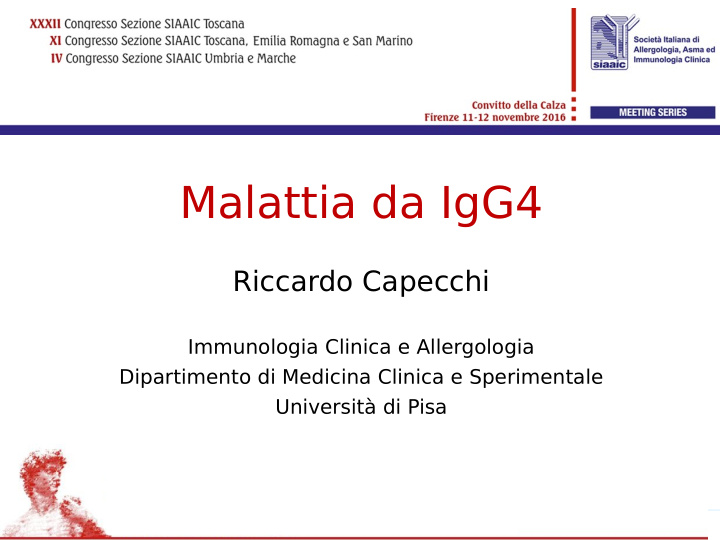



Universita’ di Pisa - Facolta’ di Medicina e Chirurgia Malattia da IgG4 Riccardo Capecchi Immunologia Clinica e Allergologia Dipartimento di Medicina Clinica e Sperimentale Università di Pisa
Universita’ di Pisa - Facolta’ di Medicina e Chirurgia IgG4-Related Disease (IgG4-RD) • IgG4-RD is an immunomediated fibroinflammatory condition characterized by: • Lymphoplasmacytic infiltration • IgG4+ plasma cells in lesions • Storiform fibrosis (spindle cells having elongated nuclei radiating from a center) • Obliterative phlebitis • Mild to moderate eosinophilia • High serum IgG4 concentration (very often, not always) Prevalence: 2-3 cases/100.000 (male, 50-80 years) J Stone et al, N Engl J Med 2012 Kamisawa et al, Lancet 2015 Kanno et al, Pancreas, 2012
Universita’ di Pisa - Facolta’ di Medicina e Chirurgia
Universita’ di Pisa - Facolta’ di Medicina e Chirurgia IgG4-RD: Pathogenesis Mahajan V S et al, Annu. Rev. Pathol. Mech. Dis. 2014
Universita’ di Pisa - Facolta’ di Medicina e Chirurgia IgG4-RD: organs involvement Brito-Zerón et al, Autoimmunity Reviews 2014
Universita’ di Pisa - Facolta’ di Medicina e Chirurgia J Stone et al, N Engl J Med 2012
Universita’ di Pisa - Facolta’ di Medicina e Chirurgia IgG4-RD: Diagnosis • it is important to difgerentiate IgG4-RD from malignant tumors of each organ (e.g. cancer, lymphoma) and similar diseases (e.g. Sjögren's syndrome, primary sclerosing cholangitis, Castleman's disease, secondary retroperitoneal fjbrosis, Wegener's granulomatosis, sarcoidosis, Churg–Strauss syndrome) • Even when patients cannot be diagnosed using the CCD criteria, they may be diagnosed using organ specifjc diagnostic criteria for IgG4RD (es AIP or Mikulicz) Okazaki et al, Int J Rheumatol 2012 Okazaki et al, Autoimmun Rev 2014
Universita’ di Pisa - Facolta’ di Medicina e Chirurgia IgG4-RD: Laboratory Markers of infmammation (CRP and ESR) (20%) Increase of IgG4 (60%) Eosinophilia (30%) Increase of IgE (30%) Increase of circulating CD19+CD20-CD27+CD38+ cells (plasmablasts)
Universita’ di Pisa - Facolta’ di Medicina e Chirurgia IgG4-RD: histology IHC analysis Altamente probabile: 2/3 criteri Infjltrato linfoplasmocitoide denso Fibrosi storiforme Flebite obliterante 10-200 IgG4+ cells /campo Rapporto IgG4/IgG >40% (>50% nell’aorta) Deshpande et al, Consensus statement, Modern Pathol 2012
Universita’ di Pisa - Facolta’ di Medicina e Chirurgia Therapy Most clinical manifestations of IgG4-related disease respond quickly to glucocorticoids. These agents are the fjrst-line, standard-of-care approach for most patients. However, relapses are common. Glucocorticoids • Starting prednisolone dose 0,6 – 1 mg/kg daily. After 2-4 weeks, the dose is tapered by 5 mg every 1-2 weeks according to clinical response • Clinical improvement is rapid (after 2 weeks make a serological assessment) • A poor response to GCS raise the possibility of other diagnoses (es cancer) Steroid-sparing agents • Some experiences with azathioprine, mycophenolate mofetil and methotrexate as means of sparing patients the efgects of long-term glucocorticoids Rituximab • B-cell depletion induced by anti-CD20 targets the subset of plasma cells that produce IgG4 • Good response to therapy and some results on fjbrosis. Relapses are still common Khosroshahi A et al, Arthritis & Rheumatology 2015
Universita’ di Pisa - Facolta’ di Medicina e Chirurgia Aim of the Study T o investigate mediators regulating fjbrotic and angiogenic processes in IgG4- RD patients Dipartimento di Medicina Interna
Universita’ di Pisa - Facolta’ di Medicina e Chirurgia Patients and Methods We recruited at the Clinical Immunology and Rheumatology Units • 13 patients fulfjlling the criteria for the diagnosis of IgG4RD • 11 normal subjects ( NHS ) Pro-fjbrotic and pro- and anti-angiogenic mediators were quantifjed in the sera of patient and control groups by ELISA at enrollment.
Universita’ di Pisa - Facolta’ di Medicina e Chirurgia Fibrosis in IgG4-RD (1) Transforming growth factor (TGF)-beta1 TGF-beta1: the main pro- fibrotic mediator. Relevant in the differentiation of fibroblasts into myofibroblasts (key cells in fibrosis). Detlefsen et al, Am J Surg Pathol 2008 Takeuchi et al, Modern Pathology 2014
Universita’ di Pisa - Facolta’ di Medicina e Chirurgia Fibrosis in IgG4-RD (2) Stromal Cell Derived Factor (SDF)-1 SDF-1 is a CXCL12 chemokine ubiquitously expressed in many tissues and cell types. It is chemotactic for mesenchymal stem cells and EPCs It is relevant in fibrosis and angiogenesis (neoplastic diseases). SDF-1 is important in the recruitment of B cells. Dipartimento di Medicina Interna
Universita’ di Pisa - Facolta’ di Medicina e Chirurgia Angiogenesis: from Physiology to Pathology VEGF Anti Anti Angiostatin Pro Pro FGF-2 Endostatin Angiopoietins HGF
Universita’ di Pisa - Facolta’ di Medicina e Chirurgia Angiogenesis in IgG4-RD (1) Vascular Endothelial Growth factor (VEGF) VEGF is the main pro- angiogenic mediator It stimulates endothelial cells by acting on VEGFR2 It is increased in inflammatory diseases, fibrosis and neoplastic diseases. Dipartimento di Medicina Interna
Universita’ di Pisa - Facolta’ di Medicina e Chirurgia Angiogenesis in IgG4-RD (2) Endostatin (ES) ES is the main endogenous inhibitor of VEGF It is produced by the cleavage of C-terminal collagen XVIII Dipartimento di Medicina Interna
Universita’ di Pisa - Facolta’ di Medicina e Chirurgia Conclusions o Levels of SDF-1 and ES (but not VEGF) are increased in IgG4-RD sera o The role of collagen degradation vs VEGF inhibition in the production of ES should be explored o Prospective studies should be planned to evaluate the role of SDF-1 and ES as biomarkers of disease activity or response to therapy
Universita’ di Pisa - Facolta’ di Medicina e Chirurgia Dipartimento di Medicina Interna
Recommend
More recommend